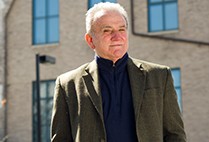By a quirk of biology, every time an adult cell divides, a bit of DNA gets lopped off the end of the double helix. This seems like a recipe for disaster—imagine a crazed librarian ripping the last chapter off a book every time it got checked out. Soon, the book would be useless. So would truncated DNA, if not for structures called telomeres, long sequences of repetitive base pairs—the same meaningless TTAGGG over and over—that cap each end of our DNA. Every time a cell divides, it’s a bit of telomere that gets chopped off, rather than vital genes.
But biologists have long understood telomeres to be a double-edged sword. When they get too short, cells stop dividing. We see this as aging: hair turns gray, skin sags. But some cells are able to keep their telomeres long, effectively becoming immortal and dividing forever. Sometimes, the immortal cells become a cancer.
Now, scientists led by Rachel L. Flynn, a School of Medicine assistant professor of pharmacology and experimental therapeutics and medicine, have found a new way to kill certain cancers by targeting mechanisms of telomere elongation. The research, funded by the National Institutes of Health, the Foster Foundation, and the Karin Grunebaum Cancer Research Foundation, and published in the January 15, 2015, issue of Science, may lead to new therapies for certain rare and deadly cancers that often appear in children.
Cells that are able to lengthen their telomeres, and thereby divide indefinitely, use two known methods to do so. The more common is to use an enzyme called telomerase, which is active in embryonic stem cells but repressed as cells become specialized. The less common method, and the one Flynn studies, is called ALT, for alternative lengthening of telomeres. The ALT pathway is most prevalent in certain cancers, including pediatric osteosarcoma, a bone cancer, and glioblastoma, a type of brain cancer.
“In terms of the possible clinical applications, this research could be a game changer,” says Karen Antman, MD, provost of Medical Campus and dean of the School of Medicine. “This exciting finding could allow us to target any cancer that uses the ALT pathway to maintain telomeres. Such cancers are often resistant to common treatment options and have a poor prognosis.”
The ALT pathway, though discovered almost two decades ago, is still poorly understood, says Flynn. “We know that ALT is a mechanism that relies on recombination—one telomere basically hijacks another and uses it to replicate and elongate itself,” she says. “But we didn’t know how the pathway was maintained until now.”
Flynn’s paper suggests how cancer cells may be able to maintain the ALT pathway—by depending on an enzyme called ATR kinase. This enzyme is what’s known as a “master regulator,” says Flynn. In a normal cell, it recognizes DNA damage when a cell is preparing to divide, and leads to either DNA repair or cell death. ALT cancer cells are constantly undergoing DNA repair at the telomere and are more reliant on ATR kinase activity than other cancer cells. Therefore, ATR promotes immortality by helping telomere elongation. Attack this enzyme, says Flynn, and you stop the cancer cell in its tracks.
“When you take ATR kinase out of the picture, it shuts down a whole chain of events,” says Flynn. “The cancer cell tries to promote telomere elongation, but it can’t, and the cell dies.”
There are several drugs already on the market that act as ATR kinase inhibitors, but none are used individually to treat these types of cancers. “The cool thing about these drugs is that the cancer cells actually die incredibly fast as opposed to just slowing down cell growth,” Flynn says. She also notes that since the drugs only affect cancer cells using the ALT pathway, normal cells should be left unharmed.
Flynn’s next step is to get the existing drugs into clinical testing for targeted use. She is working with a group at Massachusetts General Hospital who will test it on mice with glioblastomas. Eventually, she hopes, her work will lead to a new treatment for these deadly diseases.
“The dream is that this research will eventually give kids with devastating cancers an option for individualized treatment, something that will hopefully improve outcomes,” says Flynn.
A version of this article was originally published on BU Research.













































Related Stories
Dioxins Point to Targets for Treating Breast Cancer
SPH’s David Sherr follows toxins’ trail to understand aggressive cancers
Trio of Young Faculty Earn Peter Paul Professorships
BU researchers study cancer, HIV, and an aging workforce
Zebrafish Cancer Genetics Illuminate Human Breast Cancers
MED’s Hui Feng focuses on MYC gene
Post Your Comment